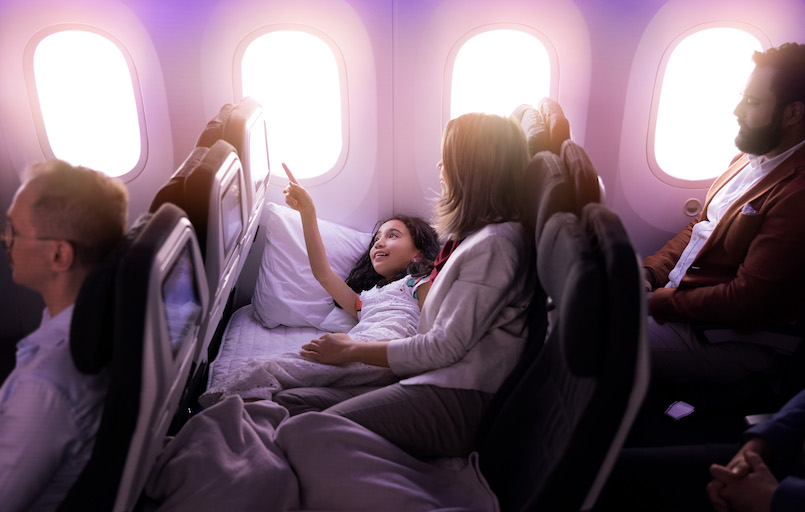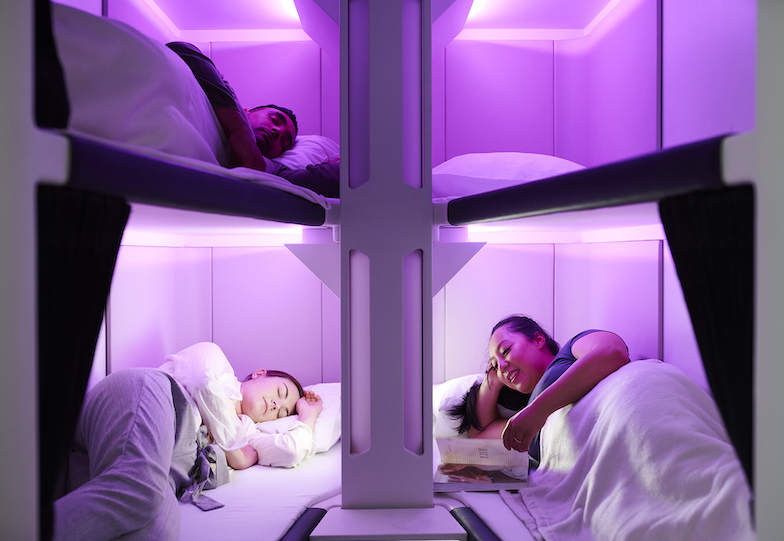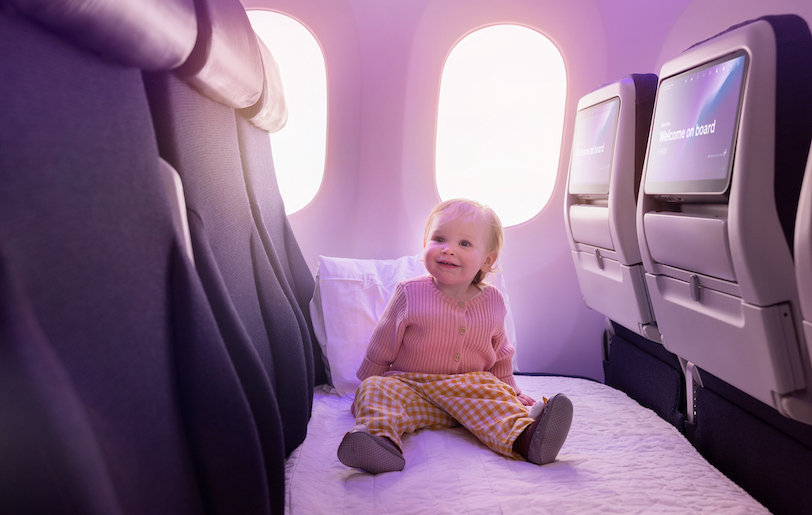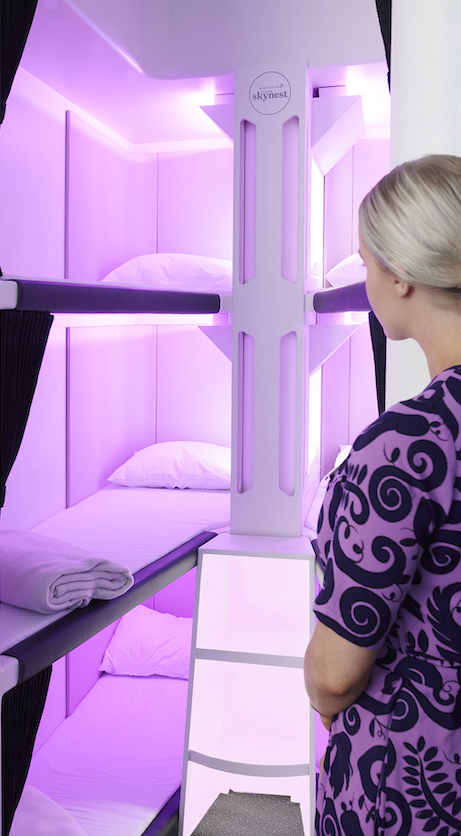
On long-haul flights Air New Zealand can adjust a row of three economy seats into a “Skycouch.” It’s not as comfortable as a twin bed but it is about 5 ft. long and is perfect for a parent with a small child. Photo by Air New Zealand
By Mary Bergin
Sliding into a middle seat between leg sprawlers and armrest hogs is a dreaded rite of passage for the economy airline passenger, especially during long-haul flights, typically defined as six hours or longer.
Forget about sweet dreams. Welcome to the nightmare of steerage Hell, albeit First World.
Your best-case scenario when holding a cheap ticket to ride? That used to be exit-row or front-of-aisle seating – but options for budget travelers finally are beginning to expand.
Finalists for the 2023 Crystal Cabin Awards, international recognition for aircraft interior design, include efforts by Air New Zealand and the Lufthansa Group to improve comfort and slumber in economy class.
Although the airlines’ new niceties are a bump up from the price of straightforward economy airfare, as reported in Simple Flying, the economy traveler’s bottom line will remain far below the cost of a business or first-class seat.
A new aerial nest
A trip to Kiwi Land tests the patience and serenity of lots of us in North America because the shortest nonstop to Auckland clocks in at 12 hours, from Los Angeles. It’s only logical for Air New Zealand to make passenger contentment a priority, even in economy, during these ultra-long hauls.
“New Zealand’s location puts us in a unique position to lead,” says Greg Foran, the airline’s CEO. “We have zeroed in on sleep, comfort and wellness because we know how important it is for our customers to arrive well-rested.”
In September 2024 the airline will introduce Skynest, a pod of triple-decker bunk beds (six, total) to rent in four-hour time slots. “It’s time to swap the headrest for some bed rest,” the airline contends. “Say hello to the world’s first sleep pods in the sky,” a project first announced in 2020.

Coming to Air New Zealand’s economy class in 2024 is the “Skynest,” a pod of triple-decker bunk beds that can be rented in four-hour intervals on 12-hour flights across the Pacific. Reclining for four hours will cost an additional $600, but that is much less than a lay-flat seat in business class. Photo by Air New Zealand.
In each pod will be a full-sized pillow, sheets, blanket, earplugs, reading light, USB outlet and lighting. A separate seatbelt ensures safety during turbulence. Bedding will be changed from one booking to the next.
“We wanted to offer our economy customers a lie-flat option and that’s how Skynest was born,” Foran says. “It’s going to be a real game changer for the economy travel experience.”
Time in Skynest tentatively will add $400 to $600 to the economy ticket, far less than booking a business class seat or suite.
Eight Boeing 787-9s (aka Dreamliners) on New York and Chicago routes will be retrofitted to make room for Skynest, as well as enhancements for premium economy and business sections (such as closed-door seating with room for two to dine inside).
Couch time at lofty heights
Less expensive on Air New Zealand and already business as usual is Skycouch, an economy row of three seats with footrests that unfold and rise to create a wider, flat surface that is more conducive to sleep – especially when adding a thin mattress and “business class quality” blanket and pillow.
It’s roughly $200 to book one of these “sleeper’s row” seats, which are available on Boeing 777 and 787-9 flights. Although smaller than a twin bed, the accommodation is a dozen inches wider than the average economy seat and about five feet long.
The airline has licensed the Skycouch concept to others in the industry. The New York Times reports that Vietnam Airlines, Azul Airlines in Brazil and Air Astana in Kazakhstan are among those following Air New Zealand’s lead. Business Insider mentions Air Austral in France and Lufthansa too; the prices vary by airline, flight and demand.

Parents facing a long trans-Pacific flight with a baby can buy three economy seats and pay an extra $200 to have them adjusted into a “Skycouch” when they fly on Air New Zealand. Photo by Air New Zealand.
Overhaul for the long haul
Under Lufthansa’s new Allegris umbrella are new seating choices for each of four travel categories (economy, premium economy, business and first class). Economy adds the possibility – based on availability – of booking (upon check-in or at the gate) a free seat next to your paid seat during long-haul flights.
The tightest pitch (distance between two rows of seats) via Allegris revamping is better than the airline industry’s average for economy class. That means more wiggle room. How much more depends on the specific seat: Pitch variance among Lufthansa’s economy seats is almost three inches.
“More personal space for maximum comfort” is how Lufthansa explains the changes, which include ergonomic seating with an adjustable headrest and almost three inches more legroom than its classic economy seats. The promise: “No matter how long the flight lasts, you will sit comfortably, enjoy excellent service” and “plenty of personal space.”
In premium economy, Allegris seats sit in a hard-shell design that increases pitch five inches beyond the roomiest Lufthansa economy seat. When flying, even an inch or two of pitch difference can feel big, and the hard-shell design means no disruption for the passenger sitting behind you.
More than 80 aircraft in the Germany-based Lufthansa Group are being equipped/retrofitted with Allegris seats. It’s a $2.7 billion investment, and conversions of Airbus A350s already have begun. Prices have not been announced; coming to First Class are private suites with temperature-controlled seating and on-demand dining.
Why not a bigger bandwagon?
Economy class typically has the most seats on a commercial aircraft, but it’s not the biggest revenue contributor. Investopedia.com says the 12 percent of airline passengers who fly business class generate up to 75 percent of airline revenue.
That may help explain why the Economy Sky Dream, a Crystal Cabin Awards finalist in 2021, sputtered in development. The design relocated overhead storage space to make room for tiers of bunk beds throughout economy.

Flight attendants will have their own Skynest in the nose of the plane beneath the cockpit.
“On some widebody aircraft, the Sky Dream would mean a reduction in passenger density, with three rather than four sitting in the middle section,” reports Simple Flying, but concept designer ADSE argued the shortcoming could be offset by extra revenue generated by consumer demand for the bunks.
Revenue, however, isn’t the only factor that complicates ideas to improve budget-class seating on airplanes. From Aerotime.aero:
“The industry is conservative. Even if some operators acknowledge the originality and brilliance of some designs, no one wants to be first. Incremental iterations of an existing product are usually preferred over more disruptive, but also riskier, changes.”
Aerotime compares such innovations to fashion designers who dream up outrageous clothing ensembles for the runway even though they know the creations aren’t retail material.
Practical limitations
Then factor in all the practicalities involved with making an aircraft design change. How will it affect a plane’s weight and safety? Does it adhere to government regulations? Are materials flammable? Durable? Recyclable? Costly?
Allied Market Research concludes that it’s a delicate balancing act between cost and aesthetics.
“Airline operators are increasingly retrofitting their fleet and upgrading their aircraft seats, as the old seats have become outdated,” the research and consulting firm observes. “Also, several leading airlines are engaged in a modernization plan to standardize their fleet. It includes stripping out the main cabin’s economy seats and replacing them with premium economy seats that are wider and offer more legroom.”
Those upgrades likely involve materials that are lighter in weight, in an industry where every pound counts because at least 35 percent of an airline’s operating expense is for fuel.
As Aerotime explains, aircraft seat designers “do their best to make the hours you spend within the constrained space of a flying metal tube as pleasant as possible, but ultimately the industry must balance different conflicting interests and requirements.”![]()
Wisconsin’s Mary Bergin writes about travel trends and exceptional destinations, often in the U.S. Midwest. Her recent stories profiled America’s motor city of Detroit and the new generation of recreational vehicles used as mobile offices by people working remotely.

